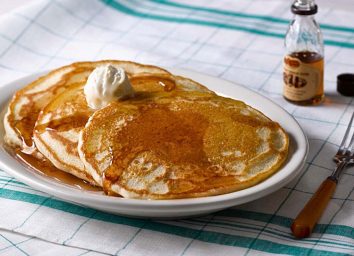The Right Way To Build a Gingerbread House, According to Bakers
Not many wintry activities can get us in the holiday spirit quite like building a gingerbread house. The perennial project not only fills your house with the festive scent of warm spices but also makes for some great bonding time. (And isn’t that what the holiday season is really all about?)
Still, building a gingerbread house from scratch requires time and effort, along with some trial and error. That’s why we spoke to professional bakers to find out their tried-and-true secrets for building a gingerbread house—one that actually looks like the perfectly piped Pinterest recipe. Here’s how bakers suggest you correctly approach constructing a gingerbread house to get the best results—and for more holiday-infused recipe tips, be sure to also check out 5 Easy Recipe Swaps To Make Your Holiday Baking Healthier.
Prep the dough in advance
You’ll want to make the dough for your gingerbread house ahead of time. It’s best to prep the dough two to three days before you plan on putting the gingerbread house together. Then, let it rest.
“Letting it rest helps the dough be firm when you roll it, and it holds its shape,” says Jürgen David, director of pastry research and development at the Institute of Culinary Education.
Cut the dough when it’s raw
Before you begin slicing away at your dough, David suggests grabbing a sturdy stencil and planning out the design out first. After all, every home—gingerbread included—begins with a good architect!
“Make sure to make clean, sharp cuts in the dough before baking, so you’ll have clean edges,” David says. “You can also use cookie cutters to make fun designs.”
Remembering to do this step will help your final product come out crisp and precise.
Chill the cut pieces before baking them
Nope, you’re not ready to pop the dough into the oven just yet! According to David, you have to stick the cut pieces in the fridge to chill in order to get the best results. Check on the dough after a minimum of two hours. However, if necessary, you can leave your dough in the fridge overnight.
Don’t underbake the dough
We know it might be tempting to pop the pieces out of the oven as soon as your timer goes off, but patience will definitely come in handy here because you don’t want underbaked gingerbread.
“I would err on the side of over-baking instead of underbaking, so [that your walls] are sturdy,” David says.
If you want to trim the pieces after baking, this is your best chance to do it. “Do so immediately when they come out of the oven so that they don’t break,” David says. “If the pieces are too soft, you can put them in a low-temperature oven and let them dry out a little longer.”
Pro tip: If the edges come out uneven after baking, use a microplane to shave them down if needed, David says. Then, once you take the pieces out of the oven, weigh them down so they stay flat until they’re completely cool.
Have at least two consistencies of royal icing
As for decorating, royal icing is classically used as the glue. “I use one part egg white to six parts confectioner’s sugar, along with a couple of drops of white vinegar [to] help it dry out faster, and a couple of tablespoons of cornstarch [to] help make it extra strong,” David says.
And to assemble and decorate like an expert baker, you’ll want a minimum of two icing consistencies: One that is very thick for gluing the pieces together, and another that’s more loose for piping details. Bear in mind that the icing you plan on using for the details shouldn’t be so loose that it drips though, advises Maria Short, a pastry chef and owner of Short N Sweet Bakery & Cafe in Hawaii.
“You can thicken [the icing] by adding more powdered sugar and/or beating more air into the icing,” Short says.
Pro tip: So that your icing doesn’t prematurely harden, keep your royal icing covered, including the opening of your icing bags. Additionally, keep all equipment wrapped in a damp paper towel for the same reason.
“And don’t worry if icing dries up and gets hard on surfaces. Simply soak in water or cover with a damp rag and it will soften and dissolve,” Short says.
Decorate the pieces while flat & let them dry
Ideally, you’ll want to decorate the gingerbread pieces while laying flat, and let the icing dry before assembling your house, according to Short. That way, you don’t risk smudging the piping and knocking down gumballs. Move the base of the house to a platter or board to make moving the house easier, and make sure to let the four walls set before attaching the roof pieces.
When it comes to the final touches, David offers up ideas on how to add a delicious dose of sweet decor to your gingerbread house. “Candy like gumdrops, mini candy canes, crushed candy canes, Twizzlers, M&M’s, and gumballs are fun to decorate with,” he suggests.
Short encourages getting creative with pantry foods you already have lying around.”Try shredded wheat cereal for thatched roofs or crackers and cookies for stepping stones,” she says.
And don’t stress if the pieces keep slipping—if you don’t have an extra set of helping hands, “use tin cans, boxes, and bottles to support your structure—and then sing some Christmas carols and eat some Christmas cookies while the icing dries firm,” Short says.
Don’t refrigerate your gingerbread house
Unlike most foods, your gingerbread house won’t last longer in the fridge. The moisture in the fridge will impact its structure, according to David.
“It will get soft and dissolve the hard candies,” Short adds.
So once your gingerbread house is fully assembled, just leave it on the kitchen counter—and make sure it’s far away from hungry hands or paws!










